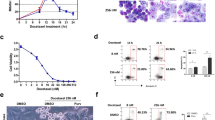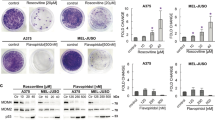Abstract
Cyclin B1 is the regulatory subunit of cyclin-dependent kinase 1 (Cdk1) and is critical for the initiation of mitosis. Accumulating data indicate that the deregulation of cyclin B1 is tightly linked to neoplastic transformation. To study the phenotype and the potential preclinical relevance, we generated HeLa cell lines stably transfected with the plasmids encompassing short hairpin RNA (shRNA) targeting cyclin B1. We demonstrate that the reduction of cyclin B1 caused inhibition of proliferation by arresting cells in G2 phase and by inducing apoptosis. Cells, entering mitosis, were impaired in chromosome condensation and alignment. Importantly, HeLa cells with reduced cyclin B1 were more susceptible to the treatment of small interfering RNA targeting Polo-like kinase 1 (Plk1) and to the administration of the chemotherapeutic agent taxol. Finally, HeLa cells with reduced cyclin B1 showed inhibited tumor growth in nude mice compared to that of control cells. In summary, our data indicate that cyclin B1 is an essential molecule for tumor cell survival and aggressive proliferation, suggesting that the downregulation of cyclin B1, especially in combination with other molecular targets, might become an interesting strategy for antitumor intervention.
This is a preview of subscription content, access via your institution
Access options
Subscribe to this journal
Receive 50 print issues and online access
$259.00 per year
only $5.18 per issue
Buy this article
- Purchase on Springer Link
- Instant access to full article PDF
Prices may be subject to local taxes which are calculated during checkout








Similar content being viewed by others
Accession codes
Abbreviations
- Cdks:
-
Cyclin-dependent kinases
- GFP:
-
Green fluorescent protein
- siRNA:
-
Small interfering RNA
- shRNA:
-
Short hairpin RNA
- XIAP:
-
X-chromosome linked inhibitor of apoptosis
References
Brandeis M, Rosewell I, Carrington M, Crompton T, Jacobs MA, Kirk J et al. (1998). Proc Natl Acad Sci USA 95: 4344–4349.
Carnero A . (2002). Br J Cancer 87: 129–133.
Chang TH, Schlegel R . (1996). J Cell Biochem 60: 161–172.
Eckerdt F, Yuan J, Strebhardt K . (2005). Oncogene 24: 267–276.
Garrett MD, Fattaey A . (1999). Curr Opin Genet Dev 9: 104–111.
Glotzer M, Murray AW, Kirschner MW . (1991). Nature 349: 132–138.
Hagting A, Karlsson C, Clute P, Jackman M, Pines J . (1998). EMBO J 17: 4127–4138.
Hassan KA, Ang KK, El-Naggar AK, Story MD, Lee JI, Liu D et al. (2002). Cancer Res 62: 6414–6417.
Hassan KA, El-Naggar AK, Soria JC, Liu D, Hong WK, Mao L . (2001). Clin Cancer Res 7: 2458–2462.
Hunter T, Pines J . (1994). Cell 79: 573–582.
Jackman M, Lindon C, Nigg EA, Pines J . (2003). Nat Cell Biol 5: 143–148.
Jin P, Hardy S, Morgan DO . (1998). J Cell Biol 141: 875–885.
Jordan MA, Wilson L . (2004). Nat Rev Cancer 4: 253–265.
Kao GD, McKenna WG, Maity A, Blank K, Muschel RJ . (1997). Cancer Res 57: 753–758.
Kaufmann WK, Schwartz JL, Hurt JC, Byrd LL, Galloway DA, Levedakou E et al. (1997). Cell Growth Differ 8: 1105–1114.
Korenaga D, Takesue F, Yasuda M, Honda M, Nozoe T, Inutsuka S . (2002). Surgery 131 (1 Suppl): 114–120.
Lehner CF, O’Farrell PH . (1990). Cell 61: 535–547.
Li J, Meyer AN, Donoghue DJ . (1997). Proc Natl Acad Sci USA 94: 502–507.
Liu X, Erikson RL . (2002). Proc Natl Acad Sci USA 99: 8672–8676.
Matthess Y, Kappel S, Spankuch B, Zimmer B, Kaufmann M, Strebhardt K . (2005). Oncogene 24: 2973–2980.
Norbury C, Nurse P . (1992). Annu Rev Biochem 61: 441–470.
Park M, Chae HD, Yun J, Jung M, Kim YS, Kim SH et al. (2000). Cancer Res 60: 542–545.
Pines J, Hunter T . (1989). Cell 58: 833–846.
Sarafan-Vasseur N, Lamy A, Bourguignon J, Pessot FL, Hieter P, Sesboue R et al. (2002). Oncogene 21: 2051–2057.
Senderowicz AM . (2003). Oncogene 22: 6609–6620.
Shen M, Feng Y, Gao C, Tao D, Hu J, Reed E et al. (2004). Cancer Res 64: 1607–1610.
Sherr CJ, Roberts JM . (2004). Genes Dev 18: 2699–2711.
Solomon MJ, Glotzer M, Lee TH, Philippe M, Kirschner MW . (1990). Cell 63: 1013–1024.
Soria JC, Jang SJ, Khuri FR, Hassan KA, Liu D, Hong WK et al. (2000). Cancer Res 60: 4000–4004.
Spankuch B, Matthess Y, Knecht R, Zimmer B, Kaufmann M, Strebhardt K . (2004). J Natl Cancer Inst 96: 862–871.
Spankuch-Schmitt B, Bereiter-Hahn J, Kaufmann M, Strebhardt K . (2002). J Natl Cancer Inst 94: 1863–1877.
Takeno S, Noguchi T, Kikuchi R, Uchida Y, Yokoyama S, Muller W . (2002). Cancer 94: 2874–2881.
Taylor WR, DePrimo SE, Agarwal A, Agarwal ML, Schonthal AH, Katula KS et al. (1999). Mol Biol Cell 10: 3607–3622.
Toyoshima F, Moriguchi T, Wada A, Fukuda M, Nishida E . (1998). EMBO J 17: 2728–2735.
Viallard JF, Lacombe F, Dupouy M, Ferry H, Belloc F, Reiffers J . (1999). Exp Cell Res 247: 208–219.
Walsh S, Margolis SS, Kornbluth S . (2003). Mol Cancer Res 1: 280–289.
Yang J, Bardes ES, Moore JD, Brennan J, Powers MA, Kornbluth S . (1998). Genes Dev 12: 2131–2143.
Yang J, Song H, Walsh S, Bardes ES, Kornbluth S . (2001). J Biol Chem 276: 3604–3609.
Yasuda M, Takesue F, Inutsuka S, Honda M, Nozoe T, Korenaga D . (2002). J Cancer Res Clin Oncol 128: 412–416.
Yin XY, Grove L, Datta NS, Katula K, Long MW, Prochownik EV . (2001). Cancer Res 61: 6487–6493.
Yoshida T, Tanaka S, Mogi A, Shitara Y, Kuwano H . (2004). Ann Oncol 15: 252–256.
Yuan J, Eckerdt F, Bereiter-Hahn J, Kurunci-Csacsko E, Kaufmann M, Strebhardt K . (2002a). Oncogene 21: 8282–8292.
Yuan J, Kramer A, Eckerdt F, Kaufmann M, Strebhardt K . (2002b). Cancer Res 62: 4186–4190.
Yuan J, Strebhardt K . (2005). Lett Drug Design Disc 2: 274–281.
Yuan J, Yan R, Kramer A, Eckerdt F, Roller M, Kaufmann M et al. (2004). Oncogene 23: 5843–5852.
Acknowledgements
We thank Dr B Martin for his critical reading and Kai Kleiber for layout work. This work is supported by the Nationales Genomforschungsnetz (01GS0104), the Deutsche Krebshilfe (10-1212-St 1), the Deutsche Forschungsgemeinschaft (STR/8-1).
Author information
Authors and Affiliations
Corresponding author
Rights and permissions
About this article
Cite this article
Yuan, J., Krämer, A., Matthess, Y. et al. Stable gene silencing of cyclin B1 in tumor cells increases susceptibility to taxol and leads to growth arrest in vivo. Oncogene 25, 1753–1762 (2006). https://doi.org/10.1038/sj.onc.1209202
Received:
Revised:
Accepted:
Published:
Issue Date:
DOI: https://doi.org/10.1038/sj.onc.1209202
Keywords
This article is cited by
-
Prediction of Genes Involved in Lung Cancer with a Systems Biology Approach Based on Comprehensive Gene Information
Biochemical Genetics (2022)
-
Systematic identification of key functional modules and genes in esophageal cancer
Cancer Cell International (2021)
-
Overexpression of β-Arrestins inhibits proliferation and motility in triple negative breast cancer cells
Scientific Reports (2021)
-
Preparation of siRNA–PLGA/Fabʹ–PLGA mixed micellar system with target cell-specific recognition
Scientific Reports (2021)
-
Comparative transcriptome analysis of a taxol-producing endophytic fungus, Aspergillus aculeatinus Tax-6, and its mutant strain
Scientific Reports (2020)



